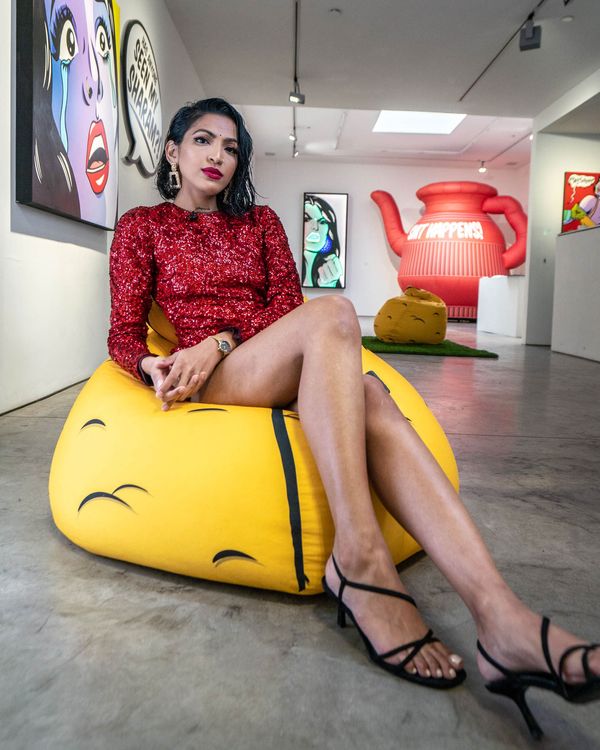
For South Asian women “Fraaaandship?” is an inside joke, an unwanted solicitation, the sound of strange men creeping into your DMs. “Fraaaandship!” is also the title of Maria Qamar’s art installation at the Richard Taittinger Gallery, on display through September 2. Qamar is a Pakistani-Canadian artist who rose to prominence on Instagram, where she illustrates the experiences of South Asian millennial women as soap-operatic, Roy Lichtenstein–inspired pop art.
Sometimes Qamar’s women are crying and lovelorn. Other times they’re glossy-haired containers of rage that leap colorfully, fantastically off the canvas. In the installation’s titular work, a bloody, disembodied male hand grabs a lavender-skinned woman by the arm. “FRAAAANDSHIP?” he asks. The woman’s “NO” reverberates through the gallery’s white walls.
For Qamar, “Fraaaandship!” isn’t only about lewd online connections. It’s also about genuine friendship, and the bonds women make from shared experiences of abuse. “Being a woman on the internet is kind of sad, which is why we make fun of how ridiculous it is,” Qamar says. Her work isn’t all about darkness: Vinyl-and-wood-board didis (sisters) float on the gallery walls. There’s a helium-filled installation of Maggi noodles, and viewers can plop down on samosa bean-bag chairs. Qamar spoke to the Cut about her Desi upbringing, Indian soap operas, and Roy Lichtenstein.
Online harassment can be so absurd that people laugh and bond over it, but often it’s still underscored by violence. How do you use pop art to balance that tension?
A lot of my work is rooted in pain and trauma. As a Desi woman, people make you feel like you’re wrong about everything all the time. What can you do but just laugh at that? There are aspects of our culture that were designed to make us feel like we shouldn’t speak up, because that’s how tradition has always been.
I’m an extremely emotional person. It’s why I gravitate so much towards Indian soap operas. The tears and the crying and the drama in my work is also inspired by Roy Lichtenstein. If you look at a still from an Indian soap opera, and a comic-book panel from the 1940s, and a Roy Lichtenstein piece, it’s the exact same expression, the exact same drama. The tears, the crying. The obsessing over revenge or love or whatever it is. The emotion is still there. The look is still there, even though it comes from two different parts of the world. That accurately describes who I am as a person. I’m neither here nor there. I’m not either Desi or Western, I’m both.
The exhibit features pieces about sisterhood, but there are also clapbacks, like Mera Jism, Mera Hathyar! (my body is my weapon). What was it like putting those two tones side-by-side?
The women and the people in my work say things that I’ve wanted to say; that I wish I could have said when I was younger. They say things that I have said. They’re people I want to be; people I have been, and women I look up to. I’m shocked by some of our culture, by ways that I grew up. It was just, You can’t do this because you’re a woman. There’s no other reason for you not being encouraged or supported, other than the fact that you’re a girl. I found that to be ridiculous when I was 3, and ridiculous now that I’m 28. My work reflects my interior rage of being told no too many times.
It’s satisfying to see these chat bubbles that say things you wanted to say in a given moment, but didn’t, or weren’t able to. What was the inspiration behind “Mera Jism, Mera Hathyar!”?
That one’s about the policing of our bodies, especially through clothing. In the Desi community, you show a little cleavage and you’re like the worst person on the planet. My body and the way I dress has been policed since I was very young. “Mera Jism” is my response to that. My body is my weapon. I don’t like being told how to dress, or what to do. I don’t think anybody does. But I think for Desi women there’s this pressure to dress modestly and properly.
I see a lot of young Desi women come to the exhibit, Instagramming and such.
I like that young women can feel happy and safe coming into this gallery space. Whenever I do pop-ups, people talk to me about their experiences with family, about dealing with random people and abuse online. I welcome that. It makes me feel like I’m not alone. It’s important for us to claim space and be angry. If I could do an installation where people could just walk in and smash plates, I would absolutely make that happen.
I would love plates, but at least there are Maggi noodles.
Maggi is a huge part of my life. It’s the most delicious noodle on the planet. I’m pretty sure it’s 90 percent inedible, and made out of yoga-mat material. My idea was to have the Maggi noodles as balloons, floating in the middle of the gallery, like Andy Warhol’s Silver Clouds. But I think there’s a helium shortage in the world right now, so I did what I could.
Obviously there are parts of our culture that are deep and dark and that evoke rage. And then there are certain parts that are just silly. I like that it doesn’t have to make you cry all the time. That’s the motive of what I do. You can have fun. You can sit on a samosa chair and talk about patriarchy. The first step we should take is laughing in the face of adversity. Or devastation, rather. That’s how I deal with it.




